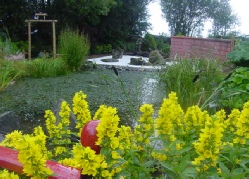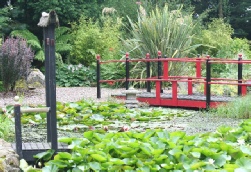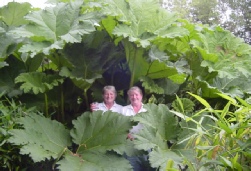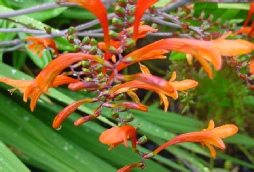Summer in the Japanese Garden
Click any picture to enlarge
Use the back button on your browser to return
Yellow loosestrife beside the bridge
Water Lilies frame the Snow Lantern
The Gunnera just gets bigger
Crocosmias beside the Pavilion




As temperatures rise, plants which have lain dormant over the winter months, and have been nudged into life during the springtime, are now in full vigour of growth. The various ferns, the Shuttlecock Fern (Matteuccia Struthiopteris), the Royal Fern (Osmunda Regalis), the Broad Buckler Fern (Dryopteris Dilatata), the Common Male Fern (Dryopteris Filix-
The bamboos have all recovered from any pain they have suffered during the winter frosts. The Japanese Acers are all now clothed in the summer finery. Beside the Japanese Bridge, we find the yellow loosetrife (Lysimachia). On the opposite side of the lower pond is the purple loosestrife, the same common name, but quite unrelated. The former is related to the primula, whilst the latter is the true loosestrife with its own family, the Lythraecae. Both add a welcome dash of colour to the garden. Another dash of colour comes from the Japanese Irises at the edge of the upper pond, here in white, purple, and a most glorious blue. Beside them one of my favourite of all primulas, Vialii, with its long straight head of pink and blue.
Up beside the waterfall, most of the colour comes from the varied shades of green of the dwarf conifers, hostas, grasses, and pines. A solitary Acer (Sango Kaku) with its pink red stems is striking. Two small specimens of Acer Dissectum Garnet give a splash of red. On the other side of the path the bright yellow/pale green of two small Acer Saraswanum catch the eye. A bamboo nigra stands at the head of the fall itself in sparkling jet black. The deep purple red of a small Australian cordyline palm nestles quietly on the rim.
On the edge of the lower pond one comes across an area of various grasses. Two Pampas Grass (Cortaderia Selloana) are backed by a row of Bamboo Nitida. In front Gardener’s Garters (Phalaris Arundinacea ‘picta’), and fronted by smaller Miscanthus, Hakonechloa, Carex, Astilbe, and two New Zealand Phormiums. Here also is a planting of Red Hot Poker, Harvest Lily, and Crocosmia Lucifer to add a light sprinkling of colour in later summer. These latter two Crocosmias also appear in a waters edge planting towards the Pavilion.
The fish now grace the pond every day, the orfe (some 30 of them now with the latest additions) swimming in shoals, some forty or so small black fish of unknown variety, and half a dozen varied goldfish which have so far managed to avoid the heron’s dreaded attention.
The tinkle of the wind chimes, the trickle of the waterfall, the soft rustle of the breeze in the warm rays of the sunshine. The serenity of the Japanese Garden, the feeling of being at one with nature.
The pleasures of life itself.